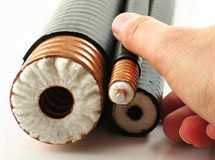According to HDcctv Alliance founder, Tod Rockoff, it was a comment at ISC West in 2008 that encouraged him to form the Alliance. A customer said: “What would be great would be unlocking high definition for the installed base”. What the customer was talking about was finding away to transmit SMPTE HD quality video across existing coxial cable plants.
Over the following year or so, Rockoff, who is an Aussie, founded the HDcctv Alliance and together with alliance partners, began to formulate a standard for transmitting HD signals over coxial cables. The core of this standard is SMPTE’s 292M standard generally called High Definition Serial Interface or HD-SDI, which has been used in TV studios to shift HD over coax for 10 years.
Very importantly, HDcctv did not develop this standard in isolation but partnered with SMPTE to form the digital HDcctv standard. What’s more, the licensing arrangement the Alliance has with SMPTE means the HDcctv standard will mirror SMPTE as higher resolutions arrive moving forward.
The key things for installers and end users to think about with HDcctv are that it really does leverage existing infrastructure in a way we all know IP Video does not. Almost universally, IP Video is kept on subnets and that means a new backbone needs to be built, along with pulling in Cat-5/6 star configs to handle individual camera-to-local-switch connections.
Now, there’s nothing whatever wrong with this layout in a Greenfield site but on a major site which has hundreds and hundreds of existing analogue cameras and associated cabling, HDcctv starts to look very appealing. HDcctv looks even better in older sites where coax is actually cemented into the fabric of the buildings themselves.
In part, it’s the longevity of the built coaxial infrastructure that ensures around 75 per cent of new cameras sold remain analogue. And sadly for security managers who are always short of money, sticking with analogue can rule out the installation of 720 and 1080p HD cameras with all their improvements in resolution and image size.
Another attraction of HDcctv is the fact signals are uncompressed which means when you’re monitoring a site like a sports arena where depths of field are huge and megapixel is such as asset, you get raw HD on your 1080p screens in the control room. And believe me, there is a noticeable difference. Other benefits include zero latency, making the standard ideal for applications like casinos where speed is vital.
With HDcctv you’ll get 100-metre transmission ranges even with the cheapest coax and there are also those benefits that accrue from being off-network, including no exposure to hacks or viruses, no network downtime for upgrade or maintenance, no need for expensive encoders and a global interface standard – the latter being something the IP Video market may never offer. Other neat features of HDcctv include 2-way audio, power over the cable and bi-direction data and control.
The most complete HDcctv range seems to be that of EverFocus which is distributed locally by Security Merchants but the word is that a number of other manufacturers are also working on compatible gear of their own in order to give installers and end users another option when it comes to getting the most from existing infrastructure.
While it’s hard to see HDcctv ultimately triumphing over IP solutions, its benefits of raw and uncompressed HD, zero latency, no encoders, use of installed coax and use of the existing installer knowledge base can’t be discounted. The HDcctv standard was designed specifically to offer HD on every coaxial input. If live monitoring is your game, that could be of interest to you.
Click to Bookmark Post
Post Bookmarked
32.4
C
Sydney
31.5
C
Canberra
31
C
Darwin
21.3
C
Hobart
24.7
C
Perth
30.6
C
Brisbane
20.1
C
Auckland
20.1
C
Melbourne










